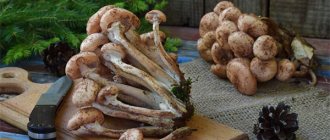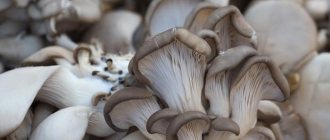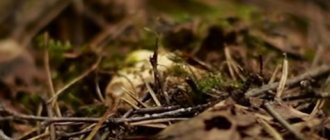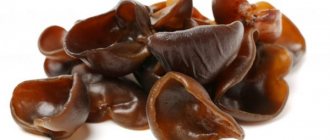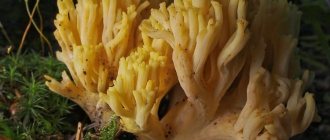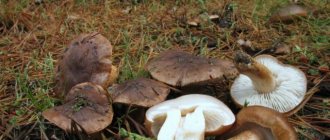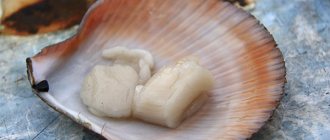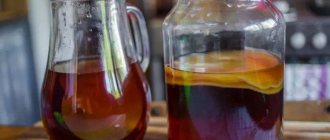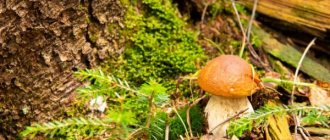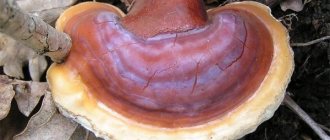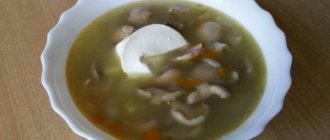Often, in order to escape from the bustle of the city, residents of megacities strive to find remote places where they can be alone with themselves and merge with nature. And the choice often falls on the forest, where mighty trees, clean air and the chirping of birds have a beneficial effect on a person’s spiritual state. But the forest not only “treats” you with spiritual food, but also allows you to find bodily food - berries, nuts and, of course, mushrooms. Majestic white, noble boletus, slender boletus, perky boletus and bright little boletus force people to comb protected paths year after year, engaged in quiet hunting. It’s worth talking about boletus separately, because... These crumbs conceal many secrets that can help a person not only satisfy his hunger, but also improve his health.
What do boletus look like and where do they grow?
The oiler belongs to the Baletaceae family, and its genus is called tubular. The mushrooms are distinguished by their oily cap, which is how they get their name. Butternuts are distinguished by their slimy skin and small ring. As a rule, the caps have different shapes depending on the species and can be either convex or flat, and the hymenophore and skin can be easily separated. The stem of the mushroom is smooth and can be decorated with a small ring. The pulp itself is yellow or white, and when cut it changes color to blue or red.
You can find boletus under larches or pines growing in temperate climates, but there are also representatives among them in hot countries, such as Australia and Africa.
By the way, the closest relative of the boletus is considered to be the most noble porcini mushroom.
Kinds
There are more than fifty varieties of boletus. They all differ from each other in external characteristics and habitats. But nevertheless, most of these mushrooms are very healthy and boast excellent taste:
- The oiler is grainy.
This species ripens at the very beginning of June, which is why it is also called “summer”. The height of such an oil dish can reach 8–10 cm, and the cap can be up to 20 cm in diameter. The color of the mushroom can vary from orange to brown with a hint of red. On sunny days, the convex or flat cap of the mushroom looks like gloss, but rain makes it quite slippery. The main feature of the species is the small nodules on the stem of the mushroom. The white (sometimes yellowish) pulp itself has a pleasant sweetish taste and fruity smell. You can find a similar type of boletus in the coniferous forest from the very beginning of summer to mid-autumn. It loves sandy soils and often grows in open areas along roads. - Larch oiler.
The bright round cap of orange, yellow-brown, red-brown colors makes this species bright and noticeable. At first the cap is convex, and then becomes flat. It has a tubular layer. The stem of the mushroom comes in yellow and brown shades, has a ring characteristic of the species and can reach 10 cm. The butterdish has an apple flavor, and the yellow flesh can darken or turn pink when cut (depending on age). It is best to go to larch forests for such mushrooms from the very beginning of summer until late autumn. - The oiler is late.
Its second name sounds like “real”, because of all types it has excellent taste and is suitable for preparing any dishes. Its white-yellow flesh has a slight fruity flavor and tends to darken when cut. The spherical and then flat cap of the mushroom is brown in color and reaches 12 cm in diameter. Rain turns a smooth “headdress” into a slippery hat. The ten-centimeter legs of a white-yellow hue smoothly turn into a cap and have brown inclusions at the very top. A membranous ring on the stalk is also present. Pine trees and super-sandy soil have become home to this species. Mushrooms usually hide under fallen plant needles, located on the edge of a forest or forest clearing. - The oiler is white.
This rare species can be seen in mixed forests. The spherical, concave-like white caps can be 12 cm in diameter. They are quite slippery and have tubes that change color from white-yellow to olive. It is not uncommon to see small droplets of pink liquid that secrete from the pores of the fungus. The slender, nine-centimeter leg of a yellowish tint is covered, as it were, with a lilac lattice. The butter dish itself has creamy flesh, an unremarkable taste and a slight mushroom aroma. This species can be found under pine or cedar. The best time to collect them is August or September. - The oiler is yellowish.
Because of its color, the mushroom began to be called “swamp”, but this does not at all overshadow its taste characteristics. The slippery cap changes depending on the weather: in the sun it turns orange, and in the rain it turns green-yellow. The height of the oiler can reach 9–10 cm, and the cap is 7 cm in diameter. There is a ring on the leg. Before frying the creamy yellow-tinged flesh that turns red when cut, you should get rid of the skin, because... the laxative property that it possesses may slightly spoil the impression of taste. If there is a swampy hill in a pine forest, then it is there, in August and September, that you can find marsh boletus. - The oiler is grey.
The fungus is gray with a purple tint, but the tubes are usually white. The ring on the stem is noticeable, but it disappears over time. The butterdish grows up to 10 cm in height, and the cap can be 9 cm. This species is not particularly distinguished by its taste, but it has a rather bright mushroom smell. From July to October you can walk into the larch forest, which is home to the gray oiler. - Cedar oiler.
This is a rare species with excellent taste. Its length is 12 cm, and the diameter of the cap is 15 cm. The leg has a thick base. It is covered with small brown spots, which are formed due to the secretion of a special whitish liquid by the pores of the fungus. The brown hat looks more like a pillow and has a bulge in the center. The fungus itself is matte, but when exposed to moisture it becomes oily. The name speaks about the habitat of these butterflies. Young cedars and pines sheltered these mushrooms, carefully covering them with leaves and pine needles. You can collect cedar butterflies throughout the summer and autumn periods.
These are the most popular types that will help diversify the usual menu, introducing a new taste and providing benefits to the human body.
How to distinguish edible boletus from false ones
In order for the butterdish to be beneficial and not harmful to health, you need to know the types of false mushrooms that can perfectly camouflage themselves as their edible counterparts:
- Panther fly agaric. This dangerous mushroom is brownish-yellow in color. Its convex cap can reach a diameter of 12 cm. The mushroom itself is slimy and covered with white growths arranged in an indefinite order or in circles. Its leg has a ring, as well as a slight thickening at the base. The smell of the mushroom is repulsive, and under the cap there are white plates. You can meet a dangerous mushroom in a coniferous forest if you go there between July and November. The mushroom is completely inedible, so to avoid poisoning, it is better to avoid it.
- Siberian butterdish. The eight-centimeter mushroom has a yellow-brown color, a convex cap with a brown and yellow tint, slippery skin, and yellow, non-darkening flesh. Its leg is covered with grain. Such an oiler can be found in a cedar forest and can easily be confused with an edible member of the family. Unlike the edible species, the Siberian is not considered as such, but it does not have toxicity. Its use is permissible if you remove the skin and boil for about half an hour. In this case, harm can be avoided.
- Pepper mushrooms can often be confused with summer and real species of these mushrooms. They grow all summer under coniferous trees. They have a convex, seven-centimeter cap that is orange or ocher. The smooth stem, 11 cm high, is painted the same color as the cap. The pulp of the mushroom is very bitter, so its taste will ruin any dish. In this regard, experts do not recommend eating this mushroom.
An experienced mushroom picker certainly knows what edible and inedible mushrooms look like. But a novice lover of “silent hunting” should use some tips to help identify a false oiler from a real one:
- Edible boletus is distinguished by a tubular surface that is similar to a sponge. Most often it is painted dark yellow.
- The whitish film located under the cap indicates that the mushroom is edible. Such a film will stretch over time and decorate the mushroom with a fluffy skirt.
- To distinguish a false mushroom, you can lightly press on it, and it will immediately crumble, which will not happen with an edible butter dish.
- Purple and gray shades, as well as an unpleasant odor, are signs of an inedible mushroom.
- If the plates of the supposed oiler are purple in color, and the ring is lilac, then such a “catch” should be discarded.
But the main rule of any mushroom picker is that if you have doubts about a mushroom, it is better to pass by it in order to avoid dangerous consequences.
Video:
10 most poisonous mushrooms in the CIS Expand
False butter beetles are a health hazard
In nature, there are no mushrooms similar to boletus that are poisonous. An experienced mushroom picker will never confuse it with another species. If there are any doubts, then just look under the cap at the spongy surface. In all poisonous types of mushrooms this surface is lamellar.
Important! There is only one type of poisonous mushroom with a spongy surface under the cap - it was called the terrible name “satanic”. However, in appearance it is absolutely not similar to the butterdish mushroom.
There are a large number of edible and conditionally edible mushrooms that are similar to boletus. Their consumption does not pose a threat to life, but can cause poisoning with serious health problems. Conditionally edible ones must be treated with caution and subjected to heat treatment for a long time.
There are only two types of butter, the consumption of which is strictly prohibited: yellow-brown and Siberian. They can be distinguished by the following features: an unpleasant odor during heat treatment, a change in color during assembly, and when cut, the leg becomes purple. They pose a particular danger to children, people with poor health and pensioners.
Read also: Deadly types of poisonous plants
Composition and calorie content
Bright butterflies are loved by housewives for their aroma and taste, which can make food more rich and nutritious, and most importantly, healthy. Unfortunately, most people do not even suspect that fungus can bring tangible benefits to human health. First of all, you should study the composition of butter, which is saturated with the following beneficial substances:
- vitamins of group B, C, A, PP;
- copper;
- iodine;
- zinc;
- phosphorus;
- iron;
- manganese;
- potassium;
- monosaccharides;
- disaccharides;
- cellulose;
- amino acids.
Butter also contains 2.4 g of protein, 0.7 g of fat, 1.7 g of carbohydrates per 100 g. The calorie content for the same weight of the product is 19 kcal.
Vita and Raly
The composition of boletus includes the most important for the healthy functioning of the human body, vita and ral. Eating mushrooms, of course, will not satisfy your full nutrient needs, but will be a good addition to a properly formulated diet.
| Name of the species | Contents per 100 grams of product | % of recommended daily intake |
| VitaB1 (tia | 0.03 mg | 2 % |
| VitaB2 (riboflavin) | 0.3 mg | 16,7 % |
| VitaB6 (pyridoxine) | 0.3 mg | 15,0 % |
| VitaB9 (folic acid) | 30.0 mcg | 7,5 % |
| VitaC (ascorbic acid) | 12 mg | 13,3 % |
| VitaPP (niacin) | 1.494 mg | 0,7 % |
rals
There is no data on the composition of macroelements in boletus. Among the microelements, iron occupies the most important place in these mushrooms.
| Ral name | Contents per 100 grams of product | % of recommended daily intake |
| Iron Fe | 1.3 mg | 7,2 % |
If you correctly approach the collection and preparation of butter, you can enrich your diet with a tasty and nutritious product. You just need to remember that there are false boletus. Therefore, when in doubt, it is best to follow the advice of experienced mushroom pickers: “If you are not sure, it is better to throw the mushroom out of the basket!”
What are the benefits of boletus?
General benefit
The list of beneficial nutrients has allowed small butter beans to become indispensable assistants in the fight against certain diseases. It also helps a person increase and maintain their health without resorting to chemicals that can harm the body.
By studying the chemical composition of the mushroom, experts found that it may well have the following positive effects on humans:
- Eating boletus can activate the body’s immune system and increase its resistance to seasonal viruses and infections.
- The growth of pathogenic bacteria will be safely stopped if the menu contains dishes with the addition of butter.
- Mushrooms contain beneficial lipids that restore liver function.
- Butter also contains styrene, substances responsible for the reproductive system and prevent erectile dysfunction.
- The same styrenes can lower blood glucose levels, which means that consuming boletus has a positive effect on the health of those who suffer from diabetes.
- Prevention of cardiovascular diseases is also included in the list of beneficial properties of mushrooms.
- In addition, boletus can lower cholesterol and reduce the risk of thrombosis and atherosclerosis.
- Improving the process of hematopoiesis and increasing hemoglobin levels is another useful property.
- The unique resinous substance contained in the oil dish will help a person cope with gout and migraines.
- The iodine content helps tissues regenerate quickly.
- Oils activate the brain and at the same time regulate the functioning of the nervous system, eliminating depression and helping to solve problems with sleep disorders.
- The intestines will be grateful to the boletus, because... they contain chitin, which helps the microflora “grow” with beneficial bifidobacteria and stimulate the functions of the adrenal glands.
- It is worth noting that in some cases, boletus can be a good prevention of cancer.
These properties that the small fungus possesses have made it indispensable in the diet of those who care about their health. But not only women, but men and children are also able to experience all the beneficial properties of the product.
For women
Women, who are responsible for caring for all family members, the comfort of the home, and its cleanliness, are most often exposed to stressful situations. That is why eating butter can calm the excited nervous system. In addition, mushrooms have a positive effect on the reproductive functions of the female body and sexual desire, so their use should be quite regular. Also, many representatives of the fair sex suffer from chronic headaches or migraines. Oils help cope with the disease. Don’t forget that oils perfectly moisturize the skin, strengthen nails and teeth. Therefore, to remain beautiful and healthy, women should consume these wonderful mushrooms.
For men
The stronger sex, unfortunately, is more at risk of heart disease. Eating boletus will have a beneficial effect on the cardiovascular system. Mushrooms will also help saturate the body with protein, which is equivalent to that of an animal. And of course, male functions and potency will be at the highest level if boletus dishes are firmly included in the diet of the strong half of humanity.
During pregnancy
A pregnant woman has to give up previously favorite and familiar dishes in order to take care of the proper formation and development of the baby. Mushrooms are considered a heavy food that can do more harm than good. But some representatives of the mushroom “kingdom” are acceptable and even recommended for consumption during pregnancy. Thus, boletus is considered a completely safe product for an expectant mother, and its benefits include the following:
- Maximum saturation of the body with nutrients with a low calorie content of the product helps satisfy hunger and regulate weight.
- The protein that the butter dish is rich in will help the proper development of the fetus.
- A woman's heart is subject to special stress when carrying a baby. Butter contains lecithin, which can support the functioning of the heart muscle during a crucial period.
- Maintaining immunity is also important for pregnant women.
- Prevention of anemia is an important component of any pregnancy, so oils that contain iron will reduce the risk of its occurrence and maintain hemoglobin at the required level.
- Regulating the nervous system and eliminating sleep problems are important qualities that mushrooms can provide to a pregnant woman.
But, despite all the positive properties of butter, it should be remembered that they can be consumed no more than twice a week in processed form. In this way, they are truly able to preserve the health of the expectant mother and contribute to the proper development of the future person.
Video:
how to eat properly during pregnancy Expand
When breastfeeding
Breast milk not only helps the newborn get enough nutrients, but also contributes to the proper formation of the baby's body. In general, mushrooms can have a beneficial effect on the health of mother and baby. But experts do not recommend eating boletus. At the very least, you should wait until the child is six months old and then try to introduce boletus dishes into the mother’s diet. It is better if it is a boiled version. But in any case, it is worth consulting with a specialist to determine the possible harm from eating butter, because there is a high risk of developing allergies and poisoning of the baby and his mother. Therefore, a conversation with a doctor is necessary.
For children
For young children, mushrooms can be dangerous rather than beneficial. The fact is that the product accumulates harmful substances, including salts of heavy metals, pesticides, radionuclides, and this cannot in any way affect the growing organism in a positive way. Pediatricians also warn that large amounts of protein upset digestive function, and chitin prevents easy absorption of the product, which is especially important in childhood.
As for butter, they can strengthen the immune system, improve brain function, strengthen the skeletal system, and maintain healthy teeth. But it is forbidden to give this type of mushroom to children until they reach the age of seven. After seven years, you can introduce your child to boletus, but it is advisable that it be a very small portion and boiled. Then the benefit will be optimal and the harm will be minimal.
When losing weight
When following a diet aimed at losing weight, nutritionists often recommend that their clients include dishes made from butter in their diet. First of all, this is useful because mushrooms satisfy hunger, and their low calorie content helps you avoid gaining extra pounds. Also, the rich protein content will be especially useful for those who are on a protein diet. In addition, the nutrients and beneficial nutrients provide the body with everything it needs and help maintain health without causing any complications associated with weight loss. Do not forget that on a diet, giving up many foods can lead to disruption of the intestinal microflora, and boletus can restore it.
Thus, boletus is a great way to diversify dietary dishes, without harming the body, but only bringing benefits and controlling weight.
Why do the body need chondroitin and glucosamine?
Glucosamine is part of chondroitin, synovium, and is a building material for cartilage, as well as tendons, ligaments and muscles, providing strength and resistance to stretching.
Chondroitin is produced by cartilage tissue and is also a component of intra-articular fluid. Due to the fact that it retains water and stimulates the production of hyaluronic acid, the strength and elasticity of the joints is maintained.
Thus, chondroitin with glucosamine for joints is necessary for the normal functioning of the osteochondral system.
With a deficiency of glucosamine and chondroitin, the quality of the synovial fluid changes, which leads to a change in the function of the joint - friction occurs between the bones and subsequent wear.
Glucosamine and chondroitin are synthesized in small quantities in the body independently, but with age, as well as during heavy physical activity, injury and inflammation, their quantity decreases and the deficiency must be replenished from the outside. If treatment is started at the wrong time, irreversible consequences begin in the joints, which can lead to osteoarthritis.
Are pickled boletus healthy?
Fresh boletus has many vitamins and microelements, but pickled mushrooms are no less useful. To evaluate their benefits, it is necessary to clarify that the content of microelements in pickled butter beans is almost the same as in fresh ones. Therefore, their benefits are as follows:
- strengthening the immune system;
- maintaining healthy and beautiful hair, strengthening nails and maintaining youthful skin;
- improvement of metabolism;
- reduction of muscle pain;
- improvement and normalization of the digestive system;
- removal of toxins;
- regulation of the hematopoietic process;
- memory improvement;
- normalization of the nervous system.
Thus, pickled butter is not only a tasty product that makes gourmets savor the oily pieces of mushroom, but also healthy, helping a person cope with many disorders of the body’s functioning. But do not forget that if you have pathologies from the digestive system, kidneys, or liver, it is not recommended to eat pickled mushrooms. It is also worth abstaining in cases where the diet does not allow the intake of any pickled food.
How to marinate
To enjoy the famous taste of pickled butter, you need to know some subtleties that allow you to properly prepare the product. Most experienced housewives and professional chefs recommend the following:
- When preparing for pickling, first remove the oily peel from the mushroom and clean it of foreign forest debris (leaves, grass, etc.). If this is not done, then the dish will give off bitter notes, and the taste will not be the same at all.
- Next, rinse the mushrooms and boil them in an enamel bowl with the addition of a small amount of salt and vinegar.
- After this, rinse the butter thoroughly and begin the marinating process, which is carried out in two ways - hot and cold. When marinating using the hot method, the butter is boiled in the marinade and then sent to jars, and the cold version involves pouring hot marinade over the mushrooms, already placed in containers.
It is also worth noting that small-sized butternuts are the most delicious. But if you come across large ones, then they should be cut into pieces.
There are a great many recipes for pickled butter, but there is one that is especially popular.
Recipe for two jars, 0.5 l capacity
Ingredients:
- 70 ml odorless sunflower oil;
- 3 tbsp. 9% vinegar;
- 1.5 tbsp. salt;
- 1 tbsp. Sahara;
- 5 cloves of garlic;
- 12 bay leaves;
- 0.5 liters of water.
Cooking method:
- Sterilize jars.
- In an enamel saucepan, combine water, salt, granulated sugar, butter and bring the marinade to a boil.
- Add the prepared butter to the boiling liquid and boil from the moment of boiling for 15 minutes.
- Next, add diced garlic, vinegar, bay leaf, stir and let cook for another 10 minutes.
- After this, fill the jars with the contents and screw on the lids.
- Leave the containers to cool under a warm blanket for two days.
Such mushrooms will not only lift your spirits with their wonderful taste, but will also benefit the entire body.
Video:
how to pickle boletus for the winter Expand
Butter delicacy
Boletus mushrooms are a treasure trove of taste and benefits, and no harm.
Boletus mushrooms are wonderful mushrooms, with a characteristic sticky, sticky skin on the cap, extremely popular among Russian mushroom pickers, and well known to everyone.
They grow in coniferous forests around the world and are famous for their satiety and rich taste. However, boletus is not only tasty, but also rich in nutrients and vitamins.
Application in medicine
Medicine is a serious science, based on research and scientific works. Officially, it uses medications for treatment, but at the dawn of its existence, doctors used plants, fruits, mushrooms and everything that nature provided as medicine. At the same time, modern medicine uses in its arsenal those beneficial substances that are contained in many products. And boletus is no exception to the rule. Of course, it is unlikely that a doctor will prescribe a prescription for drinking 0.5 liters of pickled butter three times a day, but he may well recommend them in some form to improve the condition. At the same time, it will rely on the beneficial properties proven by numerous studies of the product. Namely, doctors know the positive effects of oil extracts for the following diseases:
- allergy;
- psoriasis;
- pathologies of the organs of vision;
- diabetes;
- osteoporosis;
- migraine;
- gout;
- diseases of the cardiovascular system;
- dysfunction of the thyroid gland.
But if official medicine only recognizes the benefits, then traditional healers treat various ailments with boletus, using ancient recipes that have been tested for more than one generation.
Recipe 1
Components:
- The hats are oily.
- Vodka.
For this recipe, take a 1 liter glass jar. Place the butter caps there all the way to the top. Then pour vodka into the jar, after which this whole “potion” must stand for two weeks in the dark.
Mix the finished product in the following ratio: 1 tsp. infusion with 50 ml of water. Take 2 times a day half an hour before meals.
Area of application: headache, joint pain, mild meningitis. You can also rub the tincture on sore spots with gout and pathologies of the musculoskeletal system. In addition, the tincture perfectly improves male potency and increases sexual desire in women.
Recipe 2
Components:
- Fresh butter - 2 kg.
- Hot water – 2–3 l.
Crush the mushrooms until smooth and add hot water.
Directions for use: soak your feet in a warm bath for half an hour. After this, put on wool socks. Repeat the procedure 10 times.
Area of application: arthritis, gout.
Recipe 3
Components:
- Butter.
- Honey – 1 glass.
- Cognac – 1 glass.
Dry the mushrooms together with the film and make a powder from them, which you will need exactly half a glass. Then combine all the components and leave the preparation in the refrigerator, where it should infuse for 10 days.
Directions for use: take the medicine 3 times a day, 1 tablespoon half an hour before meals.
Area of application: tuberculosis.
These are the recipes used by healers to treat many diseases that can be treated by a small oil can, which has enormous healing power.
Benefits of oil for the body
Due to their good taste, this type of mushroom is widely used in creating various dishes. The methods of preparing them can be very diverse - marinating, frying, stewing, salting. The presence of a large amount of liquid in the structure makes boletus practically unsuitable for drying.
The chemical elements in mushrooms take an active part in the process of liver restoration and provide protection against heart and musculoskeletal diseases. In addition, some substances have a positive effect on the body's resistance to cancer.
The benefits of butter have been known since ancient times. An important factor for people who do not eat meat is the presence of a huge amount of proteins in these mushrooms. Substances necessary to maintain a healthy state of the body are also present in the structure of butter. Certain microelements provide protection against various ailments and improve the functioning of human internal organs. The presence of lecithin helps with weight loss. An aphrodisiac improves mood and gives vitality. Many components are antioxidants, and also affect energy metabolism and provide protection against inflammatory processes.
It is also a known fact that the film covering the mushroom has the property of absorbing radioactive substances and heavy elements from oxygen. It should be noted that covering young mushrooms does not pose any danger, since due to their short growth period, they do not have time to become saturated with toxins. In the case of adult boletus, it is recommended to remove the film from them, even if there are no factories or factories in the surrounding areas.
Application in cosmetology
Cosmetologists did not stand aside and appreciated the wonderful property of the small mushroom to heal the skin, keeping it youthful, nourishing and making it smoother. Oils also help strengthen hair and nails, giving them strength and increasing their beauty. Of course, on an industrial scale, mushroom extract is used to make such products, but at home it is quite possible to prepare unique masks with your own hands.
Cleansing mask
Compound:
- 1 part dried butter powder.
- 1 part fresh cucumber pulp.
- 1 part potato pulp.
Mix all ingredients and apply to face for 15 minutes, then wash with cool water. You can use the mask 2 times a week.
Moisturizing lotion
Compound:
- Fresh boletus – 50 g.
- Vegetable oil – 100 g.
- Vodka – 2 tbsp.
- Water.
Wash the mushrooms and cut them into small pieces, then put them in a 1 liter glass jar. Add oil, vodka and pour water to the very top of the dish. Close with a nylon lid and let it brew for 2 days. Use as a lotion to moisturize the skin.
Such simple recipes will help your skin become clearer and maintain its elasticity for many years.
We recommend reading:
chanterelle mushrooms in cosmetology
Read
general characteristics
The butterdish is a capped tubular mushroom. All species are mycorrhiza-formers.
The structural features of the fruiting body of this mushroom are presented in the table.
| Size | Butterflies can grow quite large, but it is recommended to eat smaller specimens: cap up to 8 cm, stem up to 6 cm. |
| hat | The surface is smooth, shiny in dry weather and oily, slimy in wet weather. Grows up to 10-15 cm. The skin is easily separated from the pulp. |
| Hymenophore | Tubular. Golden, yellow or ocher. With age it usually darkens or takes on a dirty hue. |
| Leg | Grows up to 10-12 cm. Dense, cylindrical. In adult mushrooms there may be a ring on it. |
| Color | The color of the cap varies from light brown to red-chestnut. The leg is two-colored, whitish above the ring, browner below. In some species it may coincide with the color of the cap. The pulp is yellowish, light, and in some varieties it oxidizes in air. |
| Form | In youth, the hat is a convex hemisphere, but with age it becomes like a wide cone with downward edges. The stem is cylindrical, sometimes tapering towards the base. |
| Pulp | Thick consistency. Often sour, has a pleasant aroma. The cut may change color to blue or red. |
Harm and contraindications
Any product has its drawbacks, which can negatively affect human health. Butternuts also have contraindications for use, which include:
- gastritis;
- children under 7 years of age;
- diseases of the gastrointestinal tract;
- renal failure;
- liver diseases;
- lactation period.
In addition, do not forget that mushrooms should be consumed in moderation, because... The product is quite heavy and can cause nausea and vomiting if you overeat. Don’t forget that these are mushrooms, so you need to be sure that the basket contains an edible butter dish and not its false relative.
How to prepare for the winter
Freezing
One option to preserve a perishable product for the winter is to freeze it. The choice of method will depend on the amount of raw materials collected, quality and size. You can freeze mushrooms in the following form:
- boiled;
- fresh, whole;
- raw, chopped into small pieces;
- scrolled through a meat grinder.
Drying
Dried boletus not only retains all its beneficial properties, but also acquires a wonderful aroma. You can dry them:
- on a thread
- in a dryer over a gas or electric stove;
- using an electric dryer;
- in the oven;
- using an air fryer.
When to collect and how to store
To enjoy tasty and healthy boletus, you need to go to the edges or forest clearings of coniferous or larch forests in the summer. Mushroom picking continues until late autumn. It is better if you do this after a warm mushroom rain - then a whole basket will be provided.
Having collected the boletus, they must be immediately processed, but if there is not enough time, then the mushrooms are placed in a plastic bag and placed in the refrigerator, where the product can be stored for two days, but no longer. The fact is that after this time, the boletus begins to release harmful substances that can harm the human body.
Is it possible to freeze
Butterflies, like other mushrooms, tolerate freezing well. Such storage significantly increases the shelf life of the product. To freeze mushrooms, you need to peel them from the film, wash them and sort them. Then put them in bags and close them tightly so that foreign odors are not absorbed.
To reduce the volume of the mushrooms, you can boil them before freezing for 8–10 minutes, and then put them in bags. It is worth considering that the temperature of the freezer should not exceed +5°C.
Is it possible to dry
To increase the shelf life of butter, they can not only be frozen, but also dried. With this treatment, the shelf life can be increased to 1.5 years.
Before drying mushrooms, they should be washed and cleared of films. Larger specimens need to be cut into large pieces. Next, you can take advantage of natural conditions and dry the mushrooms in the sun, but if time is short and cloudy, then it is better to choose the option of drying in the oven. With this method, the mushrooms need to be laid out on a baking sheet and dried with the door open at a temperature of 50°C. Such mushrooms should be stored in fabric bags.
Trehalase deficiency or mushroom poisoning?
Trehalase deficiency is an intolerance to fungi and is a hereditary problem. In our latitudes, the only source of trehalase is mushrooms, and since they are not the main product of the diet, a person may not be aware of his intolerance to mushrooms. And when faced with it for the first time, it is not always possible to distinguish it from poisoning.
Symptoms of tricalase deficiency:
- distension of the stomach,
- tachycardia,
- abdominal pain,
- vomit,
- diarrhea,
- dyspnea.
The only significant difference between intolerance and poisoning is that with intoxication the body temperature rises, but with trehalase deficiency it does not.
How to clean boletus mushrooms
The process of cleaning oil is a labor-intensive, but necessary part of the “ritual”. There are several ways to clean a mushroom:
- The first cleaning option is using a knife. It is necessary to pick up one edge of the skin and try to reach it to the opposite one. Experienced mushroom pickers advise greasing the cap with oil so that the skin comes off entirely.
- The second option is suitable for those who simply do not have a knife at hand. If this happens, then you just need to break the mushroom into two halves down to the skin and spread them apart. Then the skin will easily come off on its own.
- The third cleaning option involves using boiling water. To do this, simply place the butter in boiling water for 5 minutes, and then douse it with cold water 2-3 times. The skin will come off easily.
These are the most popular ways to clean the cap. The leg is cleaned easily and simply. You just need to scrape off the heavy dirt with a knife, and the rest will be washed away with water.
How to wash your hands of oil
Experts recommend wiping your hands with sunflower oil before cleansing, or even better, wearing rubber gloves. If there are no gloves or oil and your hands are already dirty, then improvised means will come to the rescue:
- Lemon acid.
Dilute a packet of acid with 1 liter of warm water. Soak your hands in this solution for 5 minutes and wash with soap. This will help cleanse the skin and not harm it. - Lemon.
Prepare a warm bath with 1 liter of water and several large citrus fruits. Soak your hands in the solution for 5 minutes and wash with soap. In addition, you can simply wipe the blackened areas with lemon. - Vinegar.
Combine one glass of 9% vinegar with 1 liter of water and soak your hands in the product for several minutes. Then wash your hands thoroughly with soap. You should also remember that it is dangerous to pour undiluted vinegar onto your skin.
These are the most famous and effective methods of getting rid of dark spots on the skin of the hands.
Tips for selecting and processing butter
The main danger that can befall butterfly lovers is the purchase or collection of their false analogues. You should carefully study the differences between these representatives of the same group and always make sure of the quality of the products.
In addition, there are a few more nuances that will help you get the most delicious dish without risking the health of your family:
- It is better to collect boletus yourself, in suitable places. These mushrooms are rarely found in stores, because they are not grown under artificial conditions. Buying products from someone else is extremely dangerous.
- These mushrooms spoil very quickly, so they must be processed immediately after harvest. Even if there is a catastrophic lack of time, the products should be sorted, washed, peeled, boiled and frozen.
- It is recommended to cut the products, even if they are not very large, into small pieces before processing. This will allow you not to worry about their safety and taste characteristics.
Moderate and regular consumption of mushrooms will only benefit the body. You should not eat them every day, as they may cause digestive problems. It is enough to add them to the menu 2-3 times a week or even a little less often.
| Name: | Butter |
| Type: | Edible |
The common oiler grows only in symbiosis with pine, therefore it is common in coniferous or mixed forests. Mycorrhiza with the root system of the coniferous tree played an important role in the composition of the fungus. Oil can is considered one of the complex chemical substances. The benefits and harms of butter oil cannot be assessed unambiguously. The main part of the microelements of the fruiting body is valuable for humans, but there are a number of contraindications.
How to cook boletus: recipes
Butternuts are not so often used as a main dish, but their bright aroma and unusual taste help give familiar dishes a completely unusual “sound.” Chefs fry, stew, and boil butter, creating gourmet dishes from them that can inspire the most sophisticated gourmet.
Soup
Fragrant boletus combined with a creamy taste will amaze anyone.
Ingredients:
- 0.5 kg butter;
- 0.4 kg potatoes;
- 1 onion;
- 200 g processed cheese;
- 1 carrot;
- 50 ml sunflower oil;
- spices to taste.
Cooking method:
- Peel, rinse, boil for 30 minutes and fry, adding your favorite spices.
- Cut the vegetables in any way, add 2 liters of water and boil until almost fully cooked.
- Add cheese and mushrooms to the vegetable broth, bring to a boil and cook for 5 minutes.
- Then puree the soup with a blender and treat it to your loved ones.
Caviar
Mushroom caviar from boletus is a wonderful dish. It can be greased with slices of bread and served as a cold appetizer.
Ingredients:
- prepared and peeled boletus – 1 kg;
- odorless vegetable oil – 120 ml;
- onions – 2 pcs.;
- salt;
- ground black pepper.
Cooking method:
- Boil the butter until tender in water with added salt and a pinch of citric acid. Then drain the water and place the mushrooms in a colander.
- Combine fried chopped onions with mushrooms and chop using a blender.
- Next, place the product in a frying pan, add pepper, salt and cook until the water has completely evaporated. Then place the finished caviar in sterilized jars, pour sunflower oil on top and screw on the lids.
This caviar is stored in the refrigerator.
Video:
How to cook fried boletus in sour cream Expand
How to fry
Fried boletus with onions is a classic recipe that is loved by many housewives for its simplicity and wonderful taste.
Ingredients:
- 1 kg butter;
- 50 ml vegetable oil;
- 200 g onion;
- salt;
- pepper.
Cooking method:
- Pour prepared boletus into 2 liters of water, add 2 tbsp. salt and cook after boiling for 20 minutes.
- Repeat this process only 3 times.
- After this, rinse the mushrooms with plain water and leave them in a colander to drain.
- Then place the butter in a frying pan, add salt, pepper and fry until golden brown with constant stirring.
- Next, when all the water has evaporated, add more oil and chopped onion into rings. Cook until the onion turns golden brown.
You can serve boletus according to this recipe with potatoes or buckwheat.
How to boil
Most people are accustomed to fried, pickled, baked butter mushrooms, but boiled mushrooms are used for most dishes.
In order to boil mushrooms, you first need to peel and rinse them. Next, pour water into the pan and place the butter there. Add salt and cook over medium heat after boiling for half an hour. When the mushrooms are ready, they will sink to the bottom of the dish. Then you should drain the water, which can be used as broth. The mushrooms themselves need to be placed in a colander and the excess water should be allowed to drain.
Such mushrooms can be added to soups, pickles, used for frying and other dishes.
How to salt
Salted boletus is just as tasty as pickled one. Their delicate taste will delight pickle lovers in cold winter, reminiscent of warm summer and bright autumn.
Ingredients:
- 3 kg boiled butter;
- 150 g salt;
- 10–15 black peppercorns;
- 5–7 peas of allspice;
- 5–7 cloves of garlic;
- 5 dill umbrellas;
- 150 ml vegetable oil.
Cooking method:
- Take a deep and wide container, at the bottom of which place some of the salt, pepper, dill and garlic, cut into thin slices.
- Place the mushrooms on the salt with their caps facing down and again sprinkle them with a layer of salt and spices. Continue this way until the raw materials run out.
- Cover the puff pastry with a dish and place a weight on top. The mushrooms should remain in this state for 24 hours. However, they should be kept warm.
- After time, place the mushrooms in clean, prepared jars and fill with the brine obtained during settling.
- Add vegetable oil to each container in the amount necessary to cover the butter.
- Close the jars with nylon lids and put them in a cool place for 2 or 3 weeks.
The aroma of wild mushrooms and pleasant saltiness will certainly delight your guests.
Video:
how to fry boletus with potatoes Expand
How to avoid possible poisoning?
To avoid becoming a victim of intoxication with boletus, or any other types of mushrooms, they should be collected only in places with a clean environment, away from highways, railways, thermal power plants, factories, lakes and rivers with high levels of pollution.
Read also: Are stretch ceilings made from PVC films harmful to health?
Do not take mushrooms whose lower part of the cap is lamellar, since in most cases these are poisonous species. Check carefully to ensure that the cap is free of dirt, worms, and mold.
Advice! Do not collect very large mushrooms, as they accumulate the maximum amount of toxins.
Cooking butter should begin with thorough washing and soaking in salt water. If during cooking the mushrooms change their color to blue, stop eating them. Preservation should be done on the first day after collection, as the oil can quickly begins to deteriorate.
Causes
Butterflies are loved not only by people, but also by various insects and worms. If mushrooms are not collected on time, then 80% of the representatives of this species become damaged.
Eating these mushrooms is already dangerous; even if you cut out the damaged areas, it is almost impossible to get rid of the worm larvae. During their life, worms leave metabolic products in the tissues of the fungus, and these, in turn, contribute to the development of allergic reactions and intoxication.
Attention. You can reduce the likelihood of a spoiled butter dish getting into your dish by thoroughly cleaning the surface of the mushroom. The larvae are detected immediately at the stage of cleaning and cutting the butter.
Table No. 2. The main causes of oil poisoning:
Why does the oiler turn blue when cut?
Many novice lovers of quiet hunting are frightened by the blue color that appears at the place where the mushroom is cut. Almost all mushrooms turn blue when cut, but in some it appears very slightly and almost imperceptibly, and mushrooms such as boletus turn blue quite strongly, a very dark violet-blue tint appears. There is no need to be alarmed, this is quite normal and does not affect the taste. The substances that make up oil oxidize in air, which is why it turns blue.
Another representative of mushrooms that turn blue at the point of cutting is goat mushroom. This mushroom is not poisonous; it is very similar to boletus, but has a bitter taste. Therefore, it can be collected in a basket along with other mushrooms. Before frying, it is necessary to boil so that the bitterness disappears. Therefore, if you find a blue tint where the mushroom is broken, you should not throw it out of the basket; it is an edible mushroom.
The oiler turns blue when cut
Butterflies are interesting, unusual mushrooms from which you can prepare a large number of tasty and nutritious dishes. They can be canned, fried, dried. Replenish your diet with butter.
Symptoms and signs of intoxication
Primary symptoms of poisoning appear 4-6 hours after eating a mushroom dish. The severity of the clinical picture is determined by the patient’s age, the amount of mushrooms eaten and immunity.
We recommend: Are there false champignons?
Symptoms of poisoning:
- Nausea;
- Vomiting;
- Spasms in the abdominal area;
- Weakness;
- Flatulence;
- Decreased blood pressure.
Signs of poisoning with canned mushrooms have their own characteristics. A day after intoxication, botulinum toxin begins to negatively affect the central nervous system.
Signs of botulism:
- Deterioration of vision, doubling of objects.
- Constipation. Botulinum toxin causes spasm of the intestinal muscles, and the victim has problems with bowel movements.
- Impaired respiratory function: breathing becomes shallow and frequent, oxygen starvation occurs.
Proper preparation of mushrooms
After the boletus has been brought from the forest, it is necessary to process it properly. This must be done, since this type of mushroom cannot be stored for a long time. Butternuts are tubular fruiting bodies and cannot be soaked in water. They will absorb liquid and become unsuitable for salting or pickling.
Important! The product is stored in a warm room for no more than 8 hours, in the refrigerator - for a day. During this time, the fruiting body will not lose its presentation and usefulness of the composition.
How to properly process boletus after harvest:
- Carefully sort through all the mushrooms and discard those that are in doubt. Remember that even a small toadstool in preserves can lead to dire consequences.
- Spread a dry cloth, place it on the crop, sort everything by size.
- Carefully inspect the fruits and remove any spoiled or rotten ones.
- The oiler cap is covered with an oily, sticky film. Needles, grass, and small debris accumulate on it. The film is carefully lifted and removed with a sharp knife.
- Cut off the mycelium.
- Rinse the mushrooms under running water.
- Spread a thin layer onto a cotton cloth and wait for the water to drain.
Small specimens often end up in the basket and then the question arises: how to process them? The film on such mushrooms is thin, it will not affect the taste of the preparations in any way. You can simply carry out initial processing: clean the fruiting bodies with a cloth, remove debris and cut off the mycelium. Next they are washed and dried.
Advice! To better separate the film, lubricate your hands and knife with vegetable oil. The peel will not stick to the instrument and stain your hands. A kitchen sponge is often used to remove the skin.
Sources
- Maria Vladmirovna Skopinova How to write a statement of claim. Educational and practical manual; Prospect - M., 1997. - 640 p.
- Vitruk Nikolay Vitruk N.V. Volume 2. Monographs. Comments. 1963-1990; Higher school - Moscow, 1979. - 180 p.
- Kamzin Nikolay Mandatory proceedings as a simplified form of civil procedure. Court order; AUTHOR - M., 2011. - 699 p.
- Karimzhan Shakirov Forensic expertology: problems and solutions (from theory to practice); Lights - Moscow, 2016. - 263 p.
- Leva Karapetyan History of the Russian state and law; Mir - Moscow, 1977. - 605 p.
